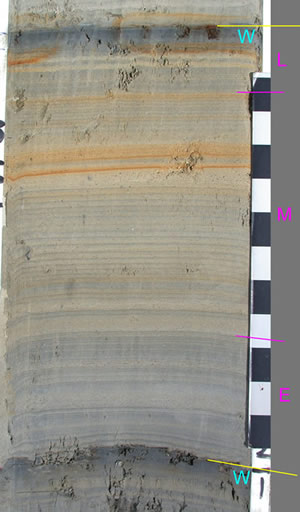Varves of the Month for 4/1/2010 - 5/2/2010
Varves along Sandy Stream, Dennistown Plantation near Jackman, Maine
This month's varves are from a bank exposure along Sandy Stream near Jackman, Maine. The varves were collected in 2003 and studied by Jonathan Nichols as part of his senior thesis at Tufts University. The varves are about 13,500 years old and were deposited in a glacial lake impounded in the basin of Wood Pond during recession of the last ice sheet that covered New England. The single varve shown here was deposited only 45 years after deglaciation at the site. We would like to thank Tom Weddle of the Maine Geological Survey for finding the section and helping us collect outcrop core samples for study. The section of varves (171 couplets) was measured and this varve record is available on our web site for download at http://ase.tufts.eduData/NortheastData/SS1LR.TXT. Unfortunately, this glacial varve record could not be matched to other records in the northeastern U.S. such as the one at Newbury, Vermont because the glacial parts of these more southerly records are too old. Varve records from the Connecticut Valley that are likely contemporaneous with the Sandy Stream record are non-glacial.
The image shows a single varve defined by winter layers (W) that are dark gray near the bottom and top of the image. The yellow lines indicate the top and bottom of the varve. This image was chosen because it displays extremely regular micro-graded units throughout the summer layer and also shows the three subdivisions of the summer layer, early (E), main (M) and late (L) melt season units, often associated with ice-proximal varves. The early and late melt season layers have more clay, and therefore tend to be darker, because of a less energetic current on the floor of the lake than during the main melt season. For an explanation of these subdivisions see also the February through April, 2009 Varve of the Month images. The orange-colored units on the image are where outcrop staining by iron has occurred.
The consistent thickness and highly repeated nature of the summer micro-graded units in all of the summer subdivisions (E, M, and L) make them strong candidates for diurnal meltwater events. There are approximately 70-80 micrograded units in the summer layer of this varve, which may indicate the minimum number of melting days during the summer in which the varve was deposited. While most of the units are normally graded they also sometimes have very subtle inverse grading near their base suggestive of a waxing and waning current flow during the deposition of each unit. This might occur if meltwater were introduced to the lake in pulses dependent on daytime sunlight and melting
Past Varves of the Month...
- 6/1/2008 - Connecticut Valley Varves at Canoe Brook, Dummerston, Vermont
- 4/27/2008 - Connecticut Valley Varves from Kelsey Ferguson Brickyard, Redland Brick Co., East Windsor, Connecticut.
- 7/1/2008 - Champlain Valley varves at Keesville, NY
- 8/1/2008 - Connecticut Valley Varves at Aldrich Brook, Westmoreland, New Hampshire
- 9/1/2008 - Connecticut Valley Varves, Perry Hill Basin (PHS), Charlestown, New Hampshire
- 10/1/2008 - Connecticut Valley Varves, Perry Hill Basin (PHN), Charlestown, New Hampshire.
- 11/1/2008 - Connecticut Valley Varves, Aldrich Brook site, Westmoreland, New Hampshire
- 12/1/2008 - Connecticut Valley Varves, Aldrich Brook site, Westmoreland, New Hampshire
- 1/1/2009 - Mine fire reclamation site, Olyphant, Pennsylvania
- 2/1/2009 - Connecticut Valley Varves, Perry Hill Basin (PHS), Charlestown, New Hampshire
- 3/1/2009 - Connecticut Valley Varves, Perry Hill Basin, Charlestown, New Hampshire
- 4/1/2009 - Connecticut Valley Varves, Perry Hill Basin, Charlestown, New Hampshire.
- 5/1/2009 - Connecticut Valley Varves, Perry Hill Basin, Charlestown, New Hampshire
- 6/1/2009 - Connecticut Valley Varves, Perry Hill Basin, Charlestown, New Hampshire
- 7/1/2009 - Connecticut Valley Varves, Perry Hill Basin, Charlestown, New Hampshire
- 8/1/2009 - Connecticut Valley Varves, Perry Hill Basin, Charlestown, New Hampshire
- 9/1/2009 - Connecticut Valley Varves, Perry Hill Basin, Charlestown, New Hampshire
- 10/1/2009 - Connecticut Valley Varves, Perry Hill Basin, Charlestown, New Hampshire
- 11/1/2009 - Connecticut Valley Varves, Perry Hill Basin, Charlestown, New Hampshire.
- 12/1/2009 - Connecticut Valley Varves, Perry Hill Basin, Charlestown, New Hampshire
- 1/1/2010 - Connecticut Valley Varves, Perry Hill Basin, Charlestown, New Hampshire
- 2/1/2010 - Varves along Starrucca Creek near Lanesboro, Pennsylvania
- 3/1/2010 - Varves in the Don Valley, Toronto
- 5/3/2010 - Varves from Glacial Lake Great Falls in Montana
- 6/4/2010 - Varves from Charlestown, NH
- 7/1/2010 - Varves from Redlands Brick Co. (Kelsey Ferguson Brickyard, South Windsor, Connecticut) - A varve that Antevs missed
- 8/1/2010 - Varves from Glastonbury, Connecticut
- 9/1/2010 - Varves from North Hatfield, Massachusetts
- 10/1/2010 - Varves from Newbury, Vermont
- 11/1/2010 - Varves from Newbury, Vermont
- 12/1/2010 - Varves from Newbury, Vermont
- 2/1/2011 - Connecticut Valley Varves at North Hatfield, Massachusetts
- 3/1/2011 - Connecticut Valley Varves Kelsey Ferguson (Redlands Brick Co.), South Windsor, Connecticut
- 6/1/2011 - Connecticut Valley Varves: Core at Scantic, East Windsor, Connecticut
- 8/1/2011 - Varves of West Canada Creek Valley, western Mohawk Valley
- 10/1/2011 - Varves of West Canada Creek Valley, western Mohawk Valley collected in Newport, NY
- 12/1/2011 - Connecticut Valley Varves at Claremont Junction, NH
- 3/1/2012 - Connecticut Valley Varves at Westmoreland, NH
- 7/1/2012 - Connecticut Valley Varves at Rt. 12A drill site in North Charlestown, N.H.



